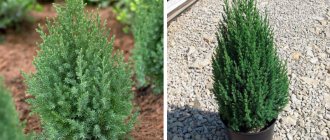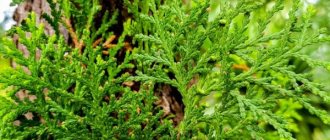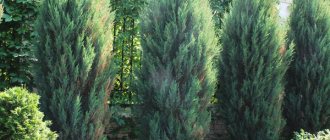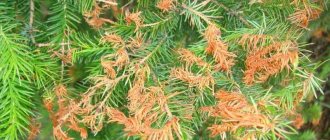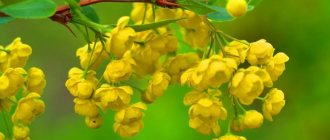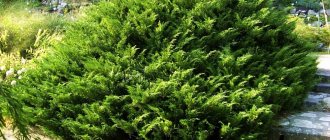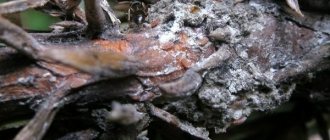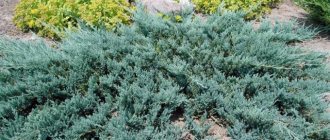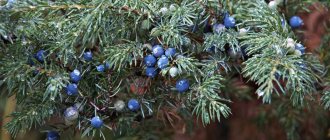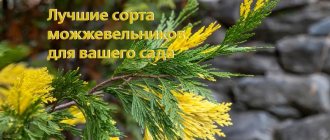The culture decorates the surrounding area with its decorative crown, purifies the air thanks to phytoncides, and some varieties are used as ground cover and earth-protective plants. Chinese juniper has straight, pin-shaped, columnar, round or spreading forms. It is unpretentious to care, but young seedlings must be protected from the effects of adverse environmental factors.
Description of Chinese juniper
Chinese species of Juniper (Juniperus chinensis) is a tree or shrub reaching up to 2.5 m in height. The crown usually resembles a cone shape and can be wide or narrow. This coniferous shrub is a popular species of ornamental plants of the Juniper genus among gardeners.
The shoots of the conifer are dark green and round. The needles are needle-shaped or scale-shaped. The cones can be elongated, spherical, first covered with a whitish coating, then turn brownish or dark blue. The seeds are almost triangular, have a special shine, and ripening occurs in the 2nd year.
You might be interested
Why do coniferous trees turn yellow?
What fertilizers for coniferous plants can be used in the garden
How to care for coniferous plants in your garden
Beneficial features
Juniper is not only beautiful, but also very useful .
Where this amazing tree grows, you don’t have to worry about the purity of the air. In just one day, juniper releases about 30 kg of phytoncides, clearing the atmosphere of pathogens.
Skin diseases are treated with decoctions of the plant The roots are used to treat bronchitis and tuberculosis, and juniper oil helps with joint diseases.
Villagers put coniferous branches of the plant in wooden containers to store mushrooms, vegetables and fruits. And the juniper broom is a useful attribute of bath procedures.
As you can see, caring for the Chinese juniper Strict is practically no hassle. Give the tree just a little attention - and fragrant pine needles, spicy berries and healthy air in the garden will be your reward .
Rules for planting and caring for Chinese Juniper
To ensure trouble-free cultivation of the crop, proper planting of Juniperus chinensis is important. To do this, choose illuminated areas where there is slight partial shade. It is better if the site has loose soil with neutral acidity.
Photos of Chinese juniper seedlings
Coniferous crops can be planted in early spring or autumn. If the second option is chosen, then try to have time to plant before October.
How to plant a bush
For planting, prepare holes up to 0.7 meters deep. Make the distance between bushes approximately 0.5 m from each other. A drainage layer consisting of expanded clay, crushed stone, and pieces of broken brick should be placed at the bottom of the hole. Then pour peat-sand soil there, place the seedling inside, sprinkle with soil mixture, water regularly for 14 days. Make sure that there is at least 10 cm from the root collar to the ground.
Watering
Established plants are very drought tolerant and like dry soils. They still require water, but you can let the soil dry out between waterings once the plants are established.
During the first three months, newly planted shrubs should be watered twice a week in the absence of precipitation. New Juniper plants will require weekly watering during the first summer to develop a complex and extensive root system. After the first summer, most plants can only grow with natural irrigation.
Fertilizer
Chinese juniper can grow on infertile soils, but not so actively. It is advisable to fertilize shrubs twice a year: in early spring and at the end of summer. Apply 200 grams of general purpose fertilizer for every 30 square meters. Feeding with a small amount of nitrogen is suitable. To feed Juniper, sprinkle fertilizer into the soil around the plants just before it rains or just before you plan to water the soil so that the fertilizer works its way into the soil and down to the roots.
Maintenance procedures consist of systematic loosening and mulching of the soil. This is necessary to retain moisture. It is enough to water adult crops once a month if there is no rain. In autumn, the bushes need to be mulched using peat or sawdust.
Note! Despite the fact that the plant is considered frost-resistant, in the first winter it is better to cover young plantings with spruce branches.
Shrub pruning
You do not need to do extensive pruning, as the shrub does not tolerate this procedure well. New green branches do not appear from mature Juniper wood, so never cut branches back to the wood. Instead of trimming your Juniper to your desired size, choose a variety of shrub that is appropriate for the location. The only pruning Junipers need is to remove dead branches. When removing dead branches, also trim needles from the bottom of the plant to increase air flow.
Tuevik drooping Variegata (Variegata)
Photo by the author
A coniferous crop with a conical crown and horizontal shoots rising at the tips is not very common in our country. Natural forms reach a height of 9-15 m, but compact, low-growing shrubs with a height of 1.5-2 m and a diameter of about 1.5 m in adulthood are usually grown in gardens. Interesting are the needles of the thuevik with rounded, shiny, flattened scales; they are painted bright green in combination with white.
Tolerates different types of soil, but prefers moist, drained, neutral soils. Does not tolerate drought and open windy areas. It grows well in full sun, but in hot climates it is preferable to plant it in an area that will receive light shade at midday. Young plants also benefit from shading in hot weather. In terms of winter hardiness, arborvitae belongs to zones 5-7; in winter it is recommended to protect the plant with a frame from snow debris and ice, which can seriously damage the crown. Tolerates pruning well.
Reproduction of coniferous shrubs
The most popular method of propagation is cuttings. The collection of material is carried out in February; young shoots with bark are used for this. The cuttings should be 7-25 cm long. It is better not to cut off the cuttings, but to tear them off so that the “heel” remains at the tip. The lower part of the seedling is treated with a growth stimulating agent, then it is placed in a soil mixture consisting of peat, humus and sand. It is not recommended to bury the branches more than 2 cm. Then cover the container with the plantings with cling film and place it in a room with good lighting, not forgetting to regularly water and spray with water. Transplantation into open soil is allowed only after 1-2 years.
Prickly spruce Bialobok / Belobok (Bialobok)
Original shape with unusual coloring. A young tree with a dense asymmetrical crown, over time it becomes conical, up to 1.5 m high and 0.6-0.9 m wide. The annual growth in height is about 15 cm. This form is most spectacular in the spring, when young growths appear with creamy white or straw yellow colored needles. Over the course of the season, the needles gradually turn silvery blue.
The plant is light-loving, but tolerates light shading. Prefers slightly acidic, moist, well-drained soils. A hardy plant that grows best in cool, moderately humid climates and does not tolerate dry and hot regions well. Does not require pruning.
Coniferous plants with unusual colors will perform best in a lighted place with loamy, fertile, permeable soils. For these conifers, fertilizing with mineral fertilizers is useful, but without excess nitrogen. Variegated needles attract the eye, and such plants will be a highlight in your garden.
Use of Juniperus chinensis in landscape design
This bush is very popular in landscape design because it can be easily modified. The plant will find a place in rockeries and hedges.
Chinese juniper Stricta in group planting
Can act as a tapeworm on lawns. Next to the crop you can plant bulbous flowers - daffodils or hyacinths.
Another popular solution among oriental gardeners is to grow the crop as a bonsai, forming the original bends of the trunk.
Features of a hedge
Coniferous crops are long-lived, which means that the fence will last for many years.
This fence has other advantages:
- limiting the area by boundary;
- multi-level tyn is a great idea for dividing the garden into zones;
- a green background will highlight flowering plants during the season and decorate the garden in the autumn;
- Coniferous plants disinfect and purify the air.
Juniper absorbs carbon dioxide and other toxic substances from the atmosphere. At the same time, it releases phytoncides and esters into the air, which have a healing effect on the human respiratory system.
Important! When planning a hedge of juniper on your site, you should know that the crop is a carrier of rust. Neighborhood with such a fence is dangerous for fruit trees. Among the disadvantages of a green fence, we can note the slow growth of the crop, as well as the susceptibility of needles to burning in some species
But patience, good care and preventive measures will give excellent results.
Among the disadvantages of green fencing, we can note the slow growth of the crop, as well as the susceptibility of needles to burning in some species. But patience, good care and preventive measures will give excellent results.
Varieties of Juniperus chinensis
Breeders have developed a fairly large number of varieties of this crop; we will briefly describe the most popular varieties.
Popular varieties of shrubs
Chinese juniper Blue Alps (Juniperus chinensis Blue Alps)
A fast-growing shrub variety, reaching 2-3m in height and up to 2m in width. A vigorous, spreading plant with short steel-blue spiny leaves. Growing rapidly, the shrub grows in successive sloping layers, preventing the development of weeds, withstanding poor soil and harsh climatic conditions.
Chinese juniper variety Stricta (Juniperus chinensis Stricta)
The shrub has a cone-shaped crown, the branches are dense and point upward. Height - up to 250 cm. The needles have a greenish-blue tint; the conifer develops quite slowly - up to 20 cm per year. Prefers only sunny areas for planting.
M. chinensis Mint Julep (Juniperus chinensis `Mint Julep`)
Reaches 200 cm in height, the crown grows 350 cm in width. A compact, spreading variety with arching branches of mint-green foliage. In cool weather the foliage darkens. An excellent focal plant, can decorate the background in border compositions or use as planting along foundations and fences. The dense foliage is perfect for a screen or hedge.
Korean fir Kohout's Icebreaker
A dwarf form with slow growth, annual growth is 3-7 cm. As a result, by 10 years the tree reaches a height of 0.6 m and a width of about 0.6-0.9 m. The young plant has a spherical crown, later it grows into a squat pyramidal tree. The curved needles, twisted into “curls,” are unusually attractive, with the upper green side of the needles being inside, and only the lower, silver-white side being visible from the outside.
Grows well in fertile, moderately moist, well-drained soils, in partial shade or sunny, sheltered from the wind. In terms of frost resistance, it belongs to the 5th zone, withstands frosts from –23 to –28°C. The garden form can be planted in rock gardens, containers, and used for grafting onto a standard.
